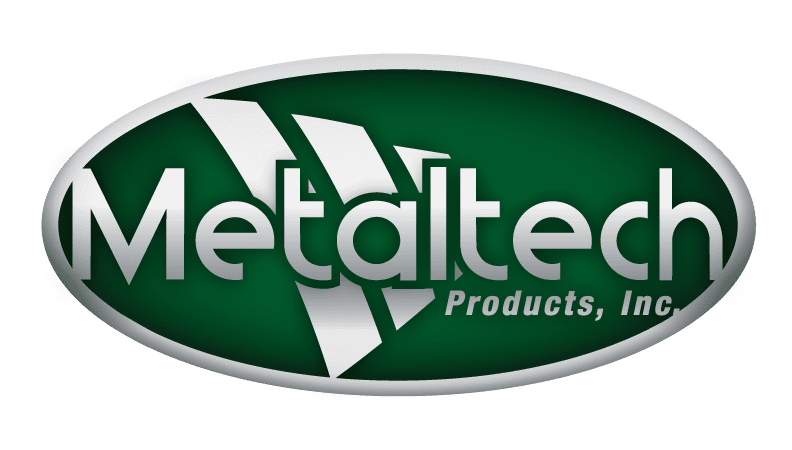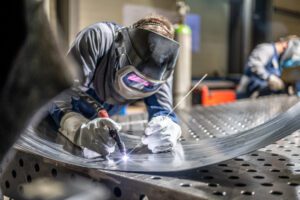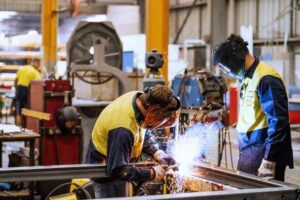Fabricated metal manufacturing includes work that shapes individual pieces of metal and joins them together into finished products or components.
As of April 2024, almost 1.47 million people work in metal fabrication in the U.S., including just over 1 million in nonsupervisory roles. Metal fabrication supplies critical components for many industries, including automotive, aerospace, construction, consumer goods, industrial manufacturing, medical equipment and many more. Thanks to its indispensable role in so many products, metal fabrication enjoys high demand and an ongoing need for talent, with excellent earnings and advancement potential.
A professional fabricator may take on one or more of the following responsibilities:
- Reading and interpreting blueprints and drawings from designers and engineers
- Creating accurate metal parts that match the blueprint
- Taking measurements and making calculations to ensure product accuracy
- Mastery of tools such as power saws, lasers, press brakes, industrial robots and welding equipment
- One or more stages in the fabrication process, such as cutting, shaping, bending, welding, machining, powder coating and assembly
If you’re interested in joining this exciting and fast-paced industry, Metaltech encourages you to apply for one of our open positions. In the meantime, let’s go over some of the knowledge and skills that will set you up for success.
Knowledge of Metals
Metal fabricators develop a detailed understanding of different types of metal, including alloys of two or more metals. This knowledge is essential, as different metals possess unique properties that determine what products they are suited for and the fabrication techniques required for best quality.
- Steel: One of the most popular metals across industries, steel is an iron alloy enriched with carbon. Varieties include stainless steel, carbon steel and alloy steel. Common applications include vehicle components, medical equipment and household appliances.
- Iron: With a high melting point, iron works well in hot environments and is often found in cookware, chains, rivets and railings.
- Aluminum: Durable, lightweight aluminum is also malleable and corrosion-resistant. Applications include power lines, kitchen utensils, window frames and airplane parts.
- Titanium: This light and strong metal is one of the most popular materials in manufacturing today. Its corrosion-resistance makes it an excellent choice for wet environments. Common uses include marine vessels, auotmotive, aerospace and medical equipment.
- Copper: Highly conducive copper is in high demand for electronics and electrical wiring. It is also found in pipes and decorative architectural structures.
- Bronze: This copper-tin alloy is also strong and non-corrosive. Uses include furniture trim, electrical connections and ship components.
- Zinc: With a low melting point, zinc is easy to cast and is often used as a coating for other metals. Applications include industrial, marine and automotive parts.
- Magnesium alloy: This easy-to-recycle material is also a good conductor of heat. It is frequently used in aerospace, automotive and communications equipment.
- Chromium: This strong, beautiful metal is often added to other metals such as steel or used as a coating.
Understanding of Tools & Techniques
Today’s advanced fabrication equipment comes with smart technologies that boost productivity, save money and create a safer working environment. For the operator on the factory floor, that means a smoother process for transforming digital blueprints into finished products with greater accuracy. Robotic arms take on repetitive and more strenuous tasks, freeing up human workers for more creative decision-making roles.
Many specialized machines are used for different stages in the metal fabrication process.
- Press brakes: A press brake literally bends metal into a desired shape for both large and small components. The operator must ensure precise bends and angles to match the blueprint.
- Drill press or punch press: Drill presses and punch presses create holes and other shapes or features for custom designs. This tool can also be adapted for grinding, polishing and other custom fabrication techniques. Holes must be a specific size called for in the blueprint.
- Grinders: The grinder is used to smooth rough or sharp edges. It can also be used to create custom shapes, cut bevels, remove burrs and shape welded parts.
- Welding: This technique involves joining two separate metal components together. The finished piece should be strong, properly aligned and have a smooth finish. Professionals become adept at a range of welding techniques including mig welding, tig welding and stick welding.
In addition to advanced machines, fabricators are also familiar with a range of hand tools for custom work such as measuring, cutting, pressing and fitting components together.
Other Basic Skills for Metal Fabrication
In addition to specialized knowledge of different metals and manufacturing techniques, the industry requires a number of general skills for success.
- Communication: As in every industry, metal fabricators must be able to collaborate with other team members to ensure product quality and follow safety guidelines.
- Manual dexterity: Fabrication requires good hand-eye coordination for precise handling of tools and materials.
- Analytical skills: The fabricator must read and understand complex technical drawings and instructions. They must choose the correct welding or other techniques to produce the component within tight tolerances.
- Physical stamina: Metal fabrication often involves standing for long periods of time and lifting heavy objects. Thanks to advances in manufacturing technology, robotic machines often take on the most challenging tasks such as heavy lifting and repetitive movements.
- Mathematics: As a fabricator, you’ll have to take accurate measurements for cutting, welding, assembly and other steps in the process.
Education & Training
Metal fabrication training involves both hands-on work and classroom instruction. Topics covered often include:
- Mathematics
- Physics, especially as it relates to the properties of different metals
- Reading blueprints
- Welding and other fabrication techniques
- Fabrication safety rules
Fabrication apprenticeships let you gain real-world experience under the guidance of an experienced professional, along with supporting classroom presentations.
Career Opportunities in Metal Fabrication
At Metaltech, our team enjoys a family atmosphere where owners often work side-by-side with operators. You’ll have a chance to diversify your skillset as you gain experience, and we prioritize your safety with our accident and illness prevention program.
If you’re ready to begin your career in the metal fabrication industry, we encourage you to apply for an open position today!




